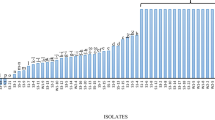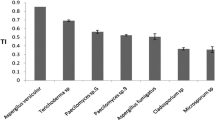Abstract
Cadmium-tolerant fungus, designated as strain FMS2, was isolated from metal-polluted soil collected from Lahore, Pakistan, and its role in cadmium bioremediation was investigated. Strain FMS2 was identified as Penicillium chrysogenum through sequence analysis of the internal transcribed spacer (ITS) regions. Physicochemical growth factors and maximum tolerance level to cadmium were determined. Cadmium uptake and bioremoval potential were analyzed by atomic absorption spectrophotometry, scanning electron microscopy and energy-dispersive spectroscopic analysis, whereas its distribution inside the fungal cell was detected by scanning transmission electron microscopy and electron energy loss spectroscopy. P. chrysogenum FMS2 was found to be resistant to cadmium with a maximum tolerance level up to 1000 mg l−1. Strain FMS2 can grow under a wide range of temperature (15–35 °C) and pH conditions (4.0–12.0). The cadmium removal capacity of strain FMS2 was observed as 49 ± 0.8% within 15 days after exposure. Distinct white patches were observed in scanning electron micrographs with clear peaks of cadmium in energy-dispersive spectroscopic spectra indicating cadmium biosorption. The scanning transmission electron micrographs and electron energy loss spectra of strain FMS2 cells revealed cytoplasmic localization of cadmium.







Similar content being viewed by others
References
Alam N, Ahmad SR, Qadir A, Ashraf MI, Lakhan C, Lakhan VC (2015) Use of statistical and GIS techniques to assess and predict concentrations of heavy metals in soils of Lahore City, Pakistan. Environ Monit Assess 187(10):e636
Al-Homaidan AA, Al-Houri HJ, Al-Hazzani AA, Elgaaly G, Moubayed NM (2014) Biosorption of copper ions from aqueous solutions by Spirulina platensis biomass. Arab J Chem 7(1):57–62
Ali H, Khan E, Ilahi I (2019) Environmental chemistry and ecotoxicology of hazardous heavy metals: environmental persistence, toxicity, and bioaccumulation. J Chem
Blaudez D, Botton B, Chalot M (2000) Cadmium uptake and subcellular compartmentation in the ectomycorrhizal fungus Paxillus involutus. Microbiology 146(5):1109–1117
Charles JB (1991) Evaluation of a rapid technique for the determination of precious metals in geological samples based on a selective aqua regia leach. Analyst 116(8):773–779
Chen SH, Cheow YL, Ng SL, Ting ASY (2019) Mechanisms for metal removal established via electron microscopy and spectroscopy: a case study on metal tolerant fungi Penicillium simplicissimum. J Hazard Mater 362:394–402
Clemens S, Antosiewicz DM, Ward JM, Schachtman DP, Schroeder JI (1998) The plant cDNA LCT1 mediates the uptake of calcium and cadmium in yeast. Proc Natl Acad Sci 95(20):12043–12048
Deshmukh R, Khardenavis AA, Purohit HJ (2016) Diverse metabolic capacities of fungi for bioremediation. Indian J Microbiol 56(3):247–264
Din G, Hassan A, Rafiq M, Hasan F, Badshah M, Khan S, Chen G, Ripp S, Shah AA (2020) Characterization of organic acid producing Aspergillus tubingensis FMS1 and its role in metals leaching from soil. Geomicrobiol J 37(4):336–344
Ezzouhri L, Castro E, Moya M, Espinola F, Lairini K (2009) Heavy metal tolerance of filamentous fungi isolated from polluted sites in Tangier, Morocco. Afr J Microbiol Res 3(2):35–48
Fazli MM, Soleimani N, Mehrasbi M, Darabian S, Mohammadi J, Ramazani A (2015) Highly cadmium tolerant fungi: their tolerance and removal potential. J Environ Health Sci 13(1):e19
Fomina MA, Alexander IJ, Colpaert JV, Gadd GM (2005) Solubilization of toxic metal minerals and metal tolerance of mycorrhizal fungi. Soil Biol Biochem 37:851–866
Gadd GM (2007) Geomycology: biogeochemical transformations of rocks, minerals, metals and radionuclides by fungi, bioweathering and bioremediation. Mycol Res 111:3–49
Gregorich EG, Carter MR (2007) Soil sampling and methods of analysis. CRC Press, Florida
Gruhn CM, Miller OK (1991) Effect of copper on tyrosinase activity and polyamine content of some ectomycorrhizal fungi. Mycol Res 95:268–272
Gupta A, Joia J, Sood A, Sood R, Sidhu C, Kaur G (2016) Microbes as potential tool for remediation of heavy metals: A review. J Microb Biochem Technol 8(4):364–372
Igiri BE, Okoduwa SI, Idoko GO, Akabuogu EP, Adeyi AO, Ejiogu IK (2018) Toxicity and bioremediation of heavy metals contaminated ecosystem from tannery wastewater: a review. J Toxicol 27:2568038
Iram S, Zaman A, Iqbal Z, Shabbir R (2013) Heavy metal tolerance of fungus isolated from soil contaminated with sewage and industrial wastewater. Pol J Environ Stud 22(3):691–697
Javaid A, Bajwa R, Javaid A (2010) Biosorption of heavy metals using a dead macro fungus Schizophyllum commune fries: evaluation of equilibrium and kinetic models. Pak J Bot 42(3):2105–2118
Javanbakht V, Alavi SA, Zilouei H (2014) Mechanisms of heavy metal removal using microorganisms as biosorbent. Water Sci Technol 69(9):1775–1787
Joo JH, Hussein KA (2012) Heavy metal tolerance of fungi isolated from contaminated soil. Korean J Soil Sci Fertil 45(4):565–571
Kanamarlapudi SLRK, Chintalpudi VK, Muddada S (2018) Application of biosorption for removal of heavy metals from wastewater. Biosorption 18:69
Kumar A, Mishra S, Kumar A, Singhal S (2017) Environmental quantification of soil elements in the catchment of hydroelectric reservoirs in India. Hum Ecol Risk Assess Int J 23(5):1202–1218
Kumar A, Cabral-Pinto M, Kumar M, Dinis PA (2020a) Estimation of risk to the eco-environment and human health of using heavy metals in the Uttarakhand Himalaya, India. Appl Sci 10(20):7078
Kumar A, Cabral-Pinto MMS, Chaturvedi AK, Shabnam AA, Subrahmanyam G, Mondal R, Gupta DK, Malyan SK, Kumar SS, Khan SA, Yadav KK (2020b) Lead toxicity: health hazards, influence on food chain, and sustainable remediation approaches. Int J Environ Res Public Health 17(7):2179
Kumar A, Subrahmanyam G, Mondal R, Cabral-Pinto MMS, Shabnam AA, Jigyasu DK, Malyan SK, Fagodiva RK, Khan SA, Kumar A, Yu ZG (2020c) Bio-remediation approaches for alleviation of cadmium contamination in natural resources. Chemosphere 268:128855
Liu YG, Fan T, Zeng GM, Li X, Tong Q, Fei YE, Zhou M, Xu W, Huang YE (2006) Removal of cadmium and zinc ions from aqueous solution by living Aspergillus niger. Trans Nonferrous Met Soc China 16(3):681–686
Malik A (2004) Metal bioremediation through growing cells. Environ Int 30(2):261–278
Manguilimotan LC, Bitacura JG (2018) Biosorption of cadmium by filamentous fungi isolated from coastal water and sediments. J Toxicol
Massaccesi G, Romero MC, Cazau MC, Bucsinszky AM (2002) Cadmium removal capacities of filamentous soil fungi isolated from industrially polluted sediments, in La Plata (Argentina). World J Microbiol Biotechnol 18(9):817–820
Mathew BB, Jaishankar M, Biju VG, Beeregowda KN (2016) Role of bioadsorbents in reducing toxic metals. J Toxicol 2016.
Mohsenzadeh F, Shahrokhi F (2014) Biological removing of cadmium from contaminated media by fungal biomass of Trichoderma species. J Environ Health Sci 12(1):102
Mounaouer B, Nesrine A, Abdennaceur H (2014) Identification and characterization of heavy metal-resistant bacteria selected from different polluted sources. Desalin Water Treat 52(37–39):7037–7052
Murtey MD, Ramasamy P (2016) Sample preparations for scanning electron microscopy–life sciences. Mod Electr Microsc Physic Life Sci. InTech
Nabizadeh R, Naddafi K, Saeedi R (2005) Biosorption of lead (II) and cadmium (II) from aqueous solutions by protonated Sargassum sp. biomass. Biotechnology 5(1):21–26
Nassiri Y, Wery J, Mansot JL, Ginsburger-Vogel T (1997) Cadmium bioaccumulation in Tetraselmis suecica: an electron energy loss spectroscopy (EELS) study. Arch Environ Con Toxicol 33(2):156–161
Oladipo OG, Awotoye OO, Olayinka A, Bezuidenhout CC, Maboeta MS (2018) Heavy metal tolerance traits of filamentous fungi isolated from gold and gemstone mining sites. Braz J Microbiol 49(1):29–37
Pan R, Cao L, Zhang R (2009) Combined effects of Cu, Cd, Pb, and Zn on the growth and uptake of consortium of Cu-resistant Penicillium sp. A1 and Cd-resistant Fusarium sp. A19. J Hazard Mater 171(1–3):761–766
Parameswari E, Lakshmanan A, Thilagavathi T (2010) Biosorption and metal tolerance potential of filamentous fungi isolated from metal polluted ecosystem. Elect J Environ Agric Food Chem 9(4):808–814
Sanchez E, Deluigi MT, Castellano G (2012) Mean atomic number quantitative assessment in backscattered electron imaging. Microsc Microanal 18(6):1355
Siddiquee S, Rovina K, Azad SA, Naher L, Suryani S, Chaikaew P (2015) Heavy metal contaminants removal from wastewater using the potential filamentous fungi biomass: a review. J Microb Biochem Technol 7(6):384–395
Tchounwou PB, Yedjou CG, Patlolla AK, Sutton DJ (2012) Heavy metal toxicity and the environment. In: Molecular, clinical and environmental toxicology. Springer, Basel, pp 133–164
Xie Y, Fan J, Zhu W, Amombo E, Lou Y, Chen L, Fu J (2016) Effect of heavy metals pollution on soil microbial diversity and bermudagrass genetic variation. Front Plant Sci 7:755
Xu X, Xia L, Huang Q, Gu JD, Chen W (2012) Biosorption of cadmium by a metal-resistant filamentous fungus isolated from chicken manure compost. Environ Technol 33(14):1661–1670
Xu X, Xia L, Zhu W, Zhang Z, Huang Q, Chen W (2015) Role of Penicillium chrysogenum XJ-1 in the detoxification and bioremediation of cadmium. Front Microbiol 6:1422
Acknowledgements
We acknowledge Higher Education Commission, Pakistan, for provision of funds under International Research Support Initiative Program and the University of Tennessee, Knoxville (USA), for providing research facilities in the Center for Environmental Biotechnology, UTK.
Funding
This work was funded by Higher Education Commission of Pakistan.
Author information
Authors and Affiliations
Contributions
GD and AAS planned over all theme of the current study. GD and AH has performed all the experimental work in laboratory along with analysis of data. GD has written this manuscript under the guidelines provided by AAS. JD and SR provided the facilities for analysis of cadmium uptake through SEM, EDS, STEM and EELS.
Corresponding author
Ethics declarations
Conflict of interest
The authors declare no conflict of interest.
Ethics approval
The current study does not include any human or animal subject; therefore, the ethical committee approval is not required.
Additional information
Editorial responsibility: Jing Chen.
Supplementary Information
Below is the link to the electronic supplementary material.
13762_2021_3211_MOESM1_ESM.tif
Dry weight of strain FMS2 cultures after 5 days of incubation at (a) different temperatures (15-35°C) and (b) under different pH ranges (4.0-12.0), with optimum growth values determined to be 30°C and pH 6.0. Error bars represent standard deviation (n = 3) (TIF 774 KB)
Rights and permissions
About this article
Cite this article
Din, G., Hassan, A., Dunlap, J. et al. Cadmium tolerance and bioremediation potential of filamentous fungus Penicillium chrysogenum FMS2 isolated from soil. Int. J. Environ. Sci. Technol. 19, 2761–2770 (2022). https://doi.org/10.1007/s13762-021-03211-7
Received:
Revised:
Accepted:
Published:
Issue Date:
DOI: https://doi.org/10.1007/s13762-021-03211-7




